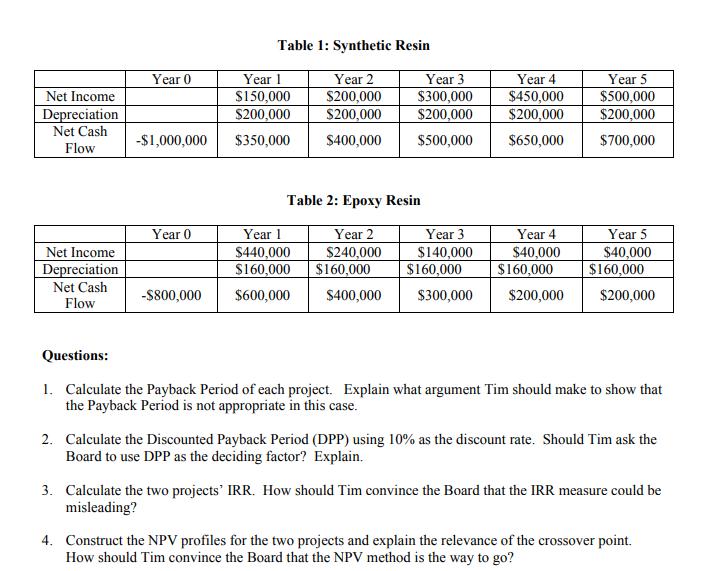Question
The Day-Pro Chemical Corporation, established in 1995, has managed to earn a consistently high rate of return on its investment. The secret of its success
The Day-Pro Chemical Corporation, established in 1995, has managed to earn a consistently high rate of return on its investment. The secret of its success has been the strategic and timely development, manufacturing, and marketing of innovative chemical products that have been used in various industries. Currently, the management of the company is considering the manufacture of a thermosetting resin as a packaging material for electrical products. The Company’s Research and Development teams have come up with two alternatives: an epoxy resin, which would have a lower startup cost, and a synthetic resin, which would cost more to produce initially but would have greater economies of scale. At the initial presentation, the project leaders of both teams presented their cash flow projections and provided sufficient documentation in support of their proposal. However, since the products are mutually exclusive, the firm can only fund one proposal. In order to resolve this dilemma, Tim Palmer, the Assistant Treasurer, and a recent MBA from a prestigious mid-western university, has been assigned the task of analyzing the costs of benefits of the two proposals and presenting his findings to the board of directors. Tim knows that this will be an uphill task since the board members are not at all on the same page when it comes to financial concepts. The Board has historically had a strong preference for using rates of return as its decision criteria. On occasions, it has also used the payback period approach to decide between competing projects. However, Tim is convinced that the net present value (NPV) method is least flawed and when used correctly will always add the most value to a company’s wealth. After obtaining the cash flow projections for each project (See Table 1 & 2) and crunching out the numbers, Tim realizes that the hill is going to be steeper than he though. The various capital budgeting techniques, when applied to the two series of cash flows, provide inconsistent results. The project with higher NPV has a longer payback and lower internal rate of return (IRR). Tim scratches his head, wondering how he can convince the Board that the IRR and payback period can often lead to incorrect decisions.

Table 1: Synthetic Resin Year 0 Year 1 Year 2 Year 3 Year 4 Year 5 $500,000 $200,000 Net Income $150,000 S200,000 $300,000 $450,000 Depreciation Net Cash $200,000 S200,000 $200,000 $200,000 -$1,000,000 $350,000 $400,000 $500,000 $650,000 $700,000 Flow Table 2: Epoxy Resin Year 3 $140,000 $160,000 Year 0 Year 1 Year 2 Year 4 Year 5 $40,000 $160,000 Net Income $440,000 $240,000 $40,000 $160,000 Depreciation Net Cash S160,000 $160,000 -S800,000 $600,000 $400,000 $300,000 $200,000 $200,000 Flow Questions: 1. Calculate the Payback Period of each project. Explain what argument Tim should make to show that the Payback Period is not appropriate in this case. 2. Calculate the Discounted Payback Period (DPP) using 10% as the discount rate. Should Tim ask the Board to use DPP as the deciding factor? Explain. 3. Calculate the two projects' IRR. How should Tim convince the Board that the IRR measure could be misleading? 4. Construct the NPV profiles for the two projects and explain the relevance of the crossover point. How should Tim convince the Board that the NPV method is the way to go?
Step by Step Solution
3.44 Rating (163 Votes )
There are 3 Steps involved in it
Step: 1
A D E F H 1 Table 1 Synthetic Resin 2 year 3 net cash flow 4 cumulative cash flow 5 present value 6 ...
Get Instant Access to Expert-Tailored Solutions
See step-by-step solutions with expert insights and AI powered tools for academic success
Step: 2

Step: 3

Ace Your Homework with AI
Get the answers you need in no time with our AI-driven, step-by-step assistance
Get Started


